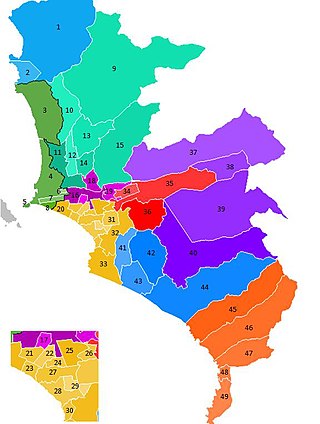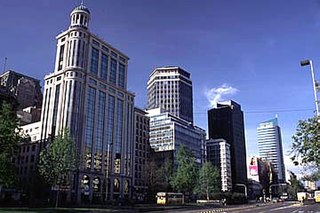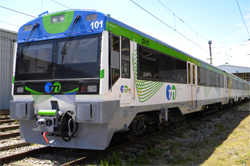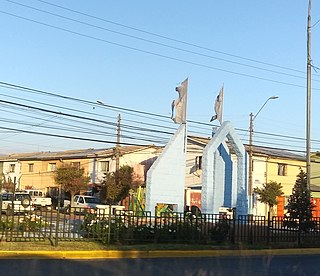Related Research Articles
Transport in Panama covers a vast network of routes predominantly traversed by cargo trucks and buses. The country's railway system, known as the Panama Canal Railway, facilitates the transportation of both passengers and goods. With a total of 15,137 km of roads, its four expressways—Corredor Sur, Corredor Norte, Autopista La Chorrera, and Colón Panama—are the arteries that link various parts of the country. Tocumen International Airport (PTY) is the key hub for international travel, ranking among the largest and most important airports in Latin America. Additionally, the renowned Panama Canal links the mere 60 km that separate the Pacific Ocean and Atlantic Ocean, offering an alternative route for maritime cargo transportation, avoiding the need to sail around South America.

TransMilenio is a bus rapid transit (BRT) system that serves Bogotá, the capital of Colombia, and Soacha, a neighbouring city. The system opened to the public in December 2000. As of 2024, 12 lines totalling 114.4 km (71 mi) run throughout the city. It is part of the city's Integrated Public Transport System, along with the urban, complementary and special bus services operating on neighbourhood and main streets.

The Libertador General Bernardo O'Higgins Region, often shortened to O'Higgins Region, is one of Chile's 16 first order administrative divisions. It is subdivided into three provinces. It is named in honour of Bernardo O'Higgins Riquelme, one of Chile's founding fathers.

Rancagua is a city and commune in central Chile and part of the Rancagua conurbation. It is the capital of the Cachapoal Province and of the O'Higgins Region, located 87 km (54 mi) south of the national capital of Santiago.

The Lima Metropolitan Area is an area formed by the conurbation of the Peruvian provinces of Lima and Callao. It is the largest of the metropolitan areas of Peru, the seventh largest in the Americas, the fourth largest in Latin America, and among the thirty largest in the world. The conurbation process started to be evident in the 1980s.

Santiago Province is one of the six provinces of the Santiago Metropolitan Region (RM) of central Chile. It encompasses the majority of the population of that region, including 31 of the 36 communities of Greater Santiago. The province spans 2,030.30 km (1,262 mi).

Alameda is a major railway station in Santiago, Chile, serving the south of the country, and is the city's primary and railway station, and is the only major railway station in Santiago after the closure of Mapocho, which used to cater trains to northern Chile. It is on the Avenida Libertador General Bernardo O'Higgins, facing Matucana avenue.

Estadio El Teniente, also known as Estadio El Teniente-Codelco for sponsorship reasons, is a multi-purpose stadium in Rancagua, Chile. It is currently used mostly for football matches. The stadium can fit 14,087 people and was built in 1945 with the name Braden Copper Company Stadium (Estadio Braden Copper Co.). The stadium is home to football club O'Higgins, which is based in Rancagua.

Transmetro is a bus rapid transit system in Guatemala City, Guatemala. The first line opened on 3 February 2007. The fleet consists of modern Volvo buses made by Ciferal in Brazil. The buses have fixed stops and partly run on dedicated lanes, avoiding other traffic. Both stops and vehicles are guarded by municipal police. Service began in 2007 with a route between the City Hall (Municipalidad) and a market place at Centra Sur. The second route, Eje Central, started operations on August 14, 2010. This route serves the central corridor between 6th and 7th Avenue of Zones 1, 4, and 9.

Central Chile is one of the five natural regions into which CORFO divided continental Chile in 1950. It is home to a majority of the Chilean population and includes the three largest metropolitan areas—Santiago, Valparaíso, and Concepción. It extends from 32° south latitude to 37° south latitude.

The Metrotrén was a Chilean commuter rail and regional rail service operated by the state-owned rail company EFE. The system started as a 134-kilometre (83 mi) line between Santiago and San Fernando, unifying between them the city of Rancagua and 23 other towns in the Metropolitan and O'Higgins regions. This line was first connected with the Santiago Metro at Alameda station, which gave the name to the service.

G.V. Florida Transport, Inc., formerly Florida Liner, is a Philippine bus company based in Barangay Matucay, Allacapan, Cagayan. Established in 1970's by Virgilio Florida, Sr., the company operates buses to Northern Luzon destinations. Currently managed by Mr. Virgilio Florida, Jr.

Estación Rancagua, is a railway station of the Empresa de los Ferrocarriles del Estado in Rancagua, Chile. It is the main railway station in the Libertador General Bernardo O'Higgins Region. Estación Rancagua is part of the Red Sur EFE, the TerraSur inter-city service, and the Metrotrén commuter service stops here.

Line 12, also known as the Golden Line from its color on the system map, is a rapid transit line of the Mexico City Metro network. It travels 25.1 kilometers (15.6 mi) along the boroughs of Benito Juárez, Iztapalapa and Tláhuac in southwestern, central-southern and southeastern Mexico City, serving twenty stations. The line was inaugurated on 30 October 2012, going from Tláhuac to Mixcoac station. In 2016, work to expand it to Observatorio station started. All the stations are accessible to people with disabilities as they have elevators, tactile pavings and braille signage plates.

Santiago Metro Line 2 is one of the seven rapid transit lines that currently make up the Santiago Metro network in Santiago, Chile. It has 26 stations and 25.9 km (16.1 mi) of track. The line intersects with Line 1 at Los Héroes, with the Line 3 at Puente Cal y Canto, with Line 4A at La Cisterna, with Line 5 at Santa Ana, and Line 6 at Franklin. It will also intersect with the future Line 7 and Line 9 at Puente Cal y Canto. Its distinctive colour on the network line map is banana yellow.

The Tomé Tragedy was the worst fans bus disaster in the history of Chilean football. The tragedy affected the O'Higgins fans after a 2013 Torneo Transición match versus Huachipato in Talcahuano, where in the Cuesta Caracol, the bus fell into a ravine about 100 meters. A bus of the public transport of Rancagua Trans O'Higgins was the vehicle that suffered the accident.

Pueblo Nuevo is a quarter of the City of Temuco, Chile. It is located in the northeast of the city, and corresponds to a residential area, with fragments used as warehouses, workshops, and electrical and transportation infrastructure. Its population was established there in the 1950s, but only in 2000 it was officially defined by the Municipality of Temuco in its Plan de desarrollo comunal. Then, in 2010, in its Diagnóstico sistémico territorial, the Municipality of Temuco modified its limits, transferring part of the territory of the Downtown and Costanera del Cautín Macrosectors, in addition to Ñielol Hill southeastern slopes. A new Territorial Diagnosis returned, in 2014, its original borders, being its current bordering macrosectors Ñielol (west), Costanera del Cautín and Downtown,.
References
- ↑ "Expreso Rancagua".
- ↑ "Los otros "Trans…" y el maquillaje de progreso, Plataforma Urbana".
- ↑ "Mapa Recorridos Rancagua" (PDF). www.mtt.gob.cl. Retrieved 2024-07-26.
- ↑ "Los recorridos que proponen los microbuseros de Rancagua para llegar al Hospital Regional".